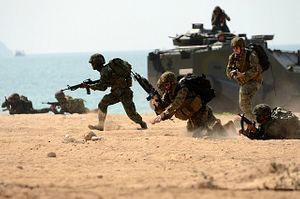This week, The Bangkok Post cited an anonymous Thai defense source as saying that the United States had planned to set up a military arms maintenance center in Thailand. Though U.S. officials have officially denied this and specifics remain unclear, this new report represents yet another manifestation of old sensitivities around such military facilities and broader enduring realities that have long dogged the U.S.-Thailand alliance.
Despite the sensationalism that often surrounds the idea of such arms facilities, in fact it is not uncommon for them to be built as part of a more robust bilateral defense relationship, whether for just the logistical purposes of maintenance or to facilitate other elements of partnership such as the transfer of technology and knowledge or even exports to other regional markets.
The idea of such facilities is also hardly new or unique within the context of the U.S.-Thailand alliance given the robust military cooperation between the two sides that continues on today (See: “Managing the U.S.-Thailand Alliance in the Trump Era”). During the Cold War, particularly as the Vietnam War escalated, the United States had such maintenance facilities in Thailand as Bangkok was a key contributor in wider U.S. regional military efforts. And even after the Vietnam War, despite drastic reductions in the U.S. military presence, U.S.-Thailand defense cooperation has continued to be quite active, whether it be in terms of exercises or arms sales and some stockpiling.
Yet it is also true that the history of the U.S.-Thailand alliance is littered with speculative accounts on either ongoing activities in existing U.S. military facilities or the construction of wholly new ones, either by the United States or other actors like China. These public accounts tend to surface when we see shifts either on the U.S. side with respect to Washington’s perceptions of its security presence in the region and the role of its allies and partners or on the Thai side regarding its outlook towards major powers and the United States.
The public accounts themselves run the gamut, from the notion of a Chinese weapons stockpile in Thailand in the late 1980s to the Thai rejection of a U.S. proposal to establish a floating arms depot in the Gulf of Thailand in the early 1990s – part of a wider regional prepositioning effort following the closure of U.S. bases in the Philippines in 1991. And, as I have observed separately, we have seen similar dynamics at work in more recent controversies that emerged during the presidency of Barack Obama within the context of an initially downgraded U.S.-Thailand defense relationship following a military coup in May 2014, which has since been gradually reversed, and some subsequent advances in Sino-Thai military ties that have concerned some in Washington (See: “Managing the Strained US-Thailand Alliance”).
This week, we witnessed yet another one of these episodes. On January 3, The Bangkok Post quoted an anonymous source from the Thai defense ministry as saying that the United States was seeking to build a new “military service depot” in Thailand and that the proposal was discussed at the 4th U.S.-Thailand Defense Strategic Talks held last month – the first round of talks since a coup had strained bilateral defense ties and just the latest sign of greater momentum for bilateral defense ties under U.S. President Donald Trump (See: “Trump’s Indo-Pacific Strategy Challenge”).
The U.S. Embassy in Bangkok has since denied that such a proposal was made at all at the talks. And the report itself offers few specifics about what exactly such a facility would look like beyond the fact that it is a maintenance center to supply and fix U.S. armaments purchased by the Thai military, with the anonymous Thai defense ministry source also admitting that discussions were preliminary and details such as where such a facility would be located remain to be worked out.
But it would not be surprising if the United States and Thailand were considering such a facility as one way of further strengthening their defense ties. After all, apart from the fact that such facilities have already been mulled in the alliance context, Bangkok has been considering proposals even from other countries which are not traditional allies, including China, for the setting up of such facilities as part of its wider defense relationships (See: “What’s With the New China-Thailand Military Facility”).
Furthermore, beyond Thailand, the United States has also been approaching other Southeast Asian states with such forms of defense collaboration as part of the wider regional picture of U.S. presence. Though part of this is motivated by the fact that U.S. allies and partners like Thailand – one of the five treaty allies the United States has in Southeast Asia and a longstanding contributor to U.S. regional and global interests – ought to be part of a conversation about Washington’s evolving security presence, there is also no doubt that some in Washington are concerned about the inroads China has made with Thailand on the security side and desire a more robust U.S.-Thailand defense relationship despite lingering concerns about Bangkok’s domestic and foreign policy outlook under the current military junta.
These evolving dynamics, which are rooted in more enduring realities, suggest that even as we see some clarity with respect to broader trends in the U.S.-Thailand defense relationship, such bouts of occasional hype on specific manifestations will not be going away anytime soon.
































